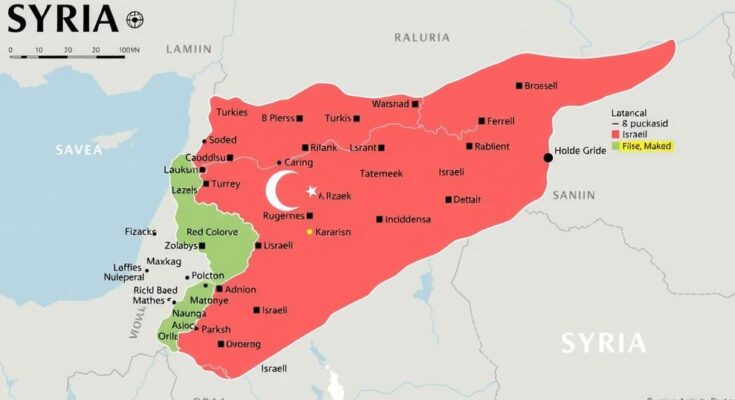The ousting of President Bashar al-Assad on December 8, 2024, presents a critical juncture for Syria, as Turkiye and Israel vie for influence. Turkiye intensifies military actions against Kurdish forces to secure its border, while Israel escalates operations against Iranian positions. The new administration under President Ahmed al-Sharaa faces the challenge of balancing relationships with both nations amid evolving regional dynamics, which will determine Syria’s future stability.
The recent ousting of President Bashar al-Assad on December 8, 2024, signifies a pivotal moment in Syrian history, introducing a new chapter influenced by shifting regional dynamics. With Turkiye and Israel vying for control, their conflicting agendas are redefining Syria’s future and impacting broader Middle Eastern stability. This change in power dynamics is anticipated to have long-lasting repercussions throughout the region.
Since the onset of the Syrian civil war in 2011, Turkiye has been fundamental in shaping the conflict. Initially, Ankara supported various armed factions opposing al-Assad’s regime, including Hayat Tahrir al-Sham (HTS). However, Turkiye’s focus has shifted toward preventing the establishment of a Kurdish autonomous entity along its border, which it views as a security threat. To mitigate this, Turkiye has intensified military operations in northern Syria, targeting Kurdish forces and creating buffer zones.
In December 2024, the Turkish-backed Syrian National Army (SNA) initiated the Manbij offensive, seizing over 200 square kilometers from the Syrian Democratic Forces (SDF). Turkiye has escalated operations against the SDF, regarded as a counterpart to the Kurdistan Workers’ Party (PKK), involving extensive aerial bombardments that have reportedly resulted in numerous casualties among Kurdish fighters and civilians. The ultimate goal remains the dismantling of Kurdish governance in northern Syria and derailing any prospects for Kurdish autonomy.
Turkiye’s military presence has grown significantly, with over 10,000 Turkish troops positioned along the northern border and new military outposts constructed in vital areas. Furthermore, Turkiye has facilitated the resettlement of over 30,000 Syrian Arab families in regions like Afrin, altering demographic balances to favor pro-Turkish factions. Alongside military operations, Turkiye has allocated approximately $2 billion for infrastructure projects, solidifying control over the territories it governs.
In parallel, Israel’s focus has been on the threat posed by Iran and Hezbollah’s influence in Syria. Following the potential power vacuum from al-Assad’s departure, Israel has increased its military activity, conducting over 80 airstrikes targeting Iranian and Hezbollah positions, particularly near the Golan Heights. Israel aims to prevent Iran from establishing a permanent military presence in Syria, which it perceives as a direct threat.
Israel’s operations have extended beyond mere military targets; it has launched high-profile strikes disrupting logistical routes for Iranian forces. Defense officials assert that Israeli airstrikes have successfully compromised much of Hezbollah’s supply network, leading to the deaths of numerous militants. Israel’s strategy stresses the urgency of degrading Iranian operations in Syria, affirming its readiness to increase airstrikes if deemed necessary.
The new administration led by President Ahmed al-Sharaa faces the intricate challenge of navigating relationships with both Turkiye and Israel, both of which have conflicting interests in Syria’s future. While engaging Turkey, Damascus expresses concerns regarding the permanent stationing of Turkish troops and maintains a cautious approach towards negotiations concerning joint security measures.
Simultaneously, al-Sharaa’s administration has adopted a more pragmatic stance toward Israel compared to al-Assad’s regime. This approach prioritizes internal stability; however, direct diplomatic relations remain elusive. Behind-the-scenes communications have taken place, but the ongoing demands regarding Iran’s military presence hinder potential engagement.
Despite the absence of direct hostilities, the competitive dynamics between Israel and Turkiye create conditions for indirect conflicts, particularly as Turkiye’s support for opposition factions stands in opposition to Israeli security interests. Strategic shifts on the battlefield have occasionally brought Turkish-backed groups into direct conflict with Israeli objectives. Such complexities are compounded by an ongoing intelligence struggle, with both nations monitoring each other’s activities closely.
As Syria transitions post-al-Assad, external elements such as the United States, Iran, and Russia remain influential in shaping the country’s trajectory. While Iran works to re-establish its influence, especially in southern Syria, Russia’s support for al-Assad complicates the resolution process. Moreover, the Gulf States, previously critical of the Assad regime, are reconsidering their positions, recognizing that pragmatic engagement may yield greater influence compared to isolation.
In summary, Syria’s future is precarious as the new government navigates intricate internal and external pressures. The ability of President al-Sharaa’s administration to balance these dynamics will significantly impact the country’s prospects for peace and stability in the ensuing years.
The recent ousting of President al-Assad marks a transformative phase in Syria’s history, characterized by renewed rivalry between Turkiye and Israel. Turkiye seeks to expand its influence, particularly against Kurdish autonomy, while Israel focuses on countering Iranian and Hezbollah threats. As the new administration under President al-Sharaa navigates these competing interests, the future of Syria hinges on their ability to implement a strategy that ensures stability and manages complex regional dynamics effectively.
Original Source: shafaq.com




